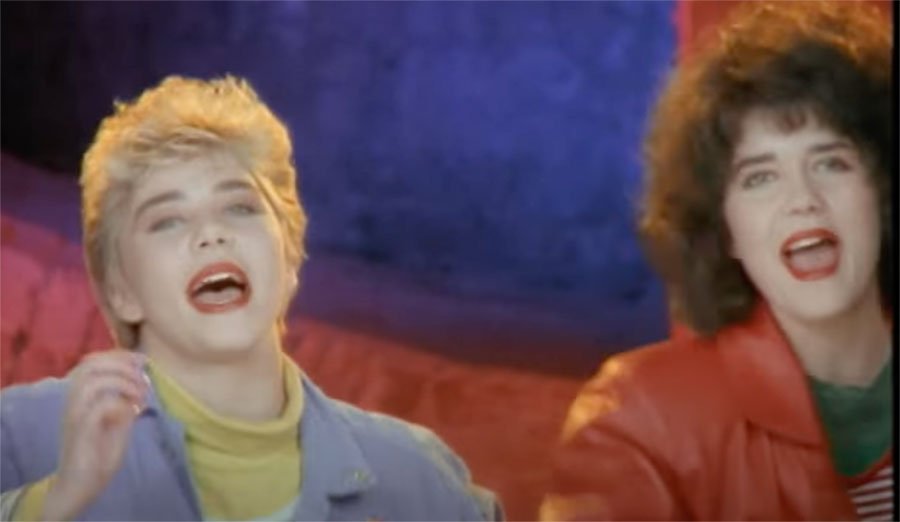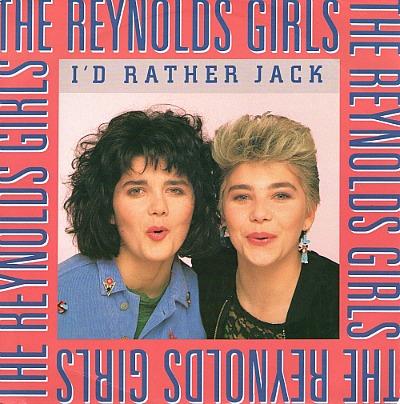
The Reynolds Girls, it seems, would rather slack than attempt a comeback. As soon as I’d Rather Jack had made them stars, Linda and Aisling Reynolds decided they didn’t fancy the pop life after all, and they’ve remained impossible to trace ever since.
Classic Pop went in search of the Liverpool sisters responsible for one of Stock Aitken Waterman’s most bizarre artistic statements…
On paper, The Reynolds Girls were perfect pop stars for Stock Aitken Waterman – two teenage sisters straight from the relatable Mel & Kim mould. However, it all went very wrong, very quickly, resulting in one of the most complete vanishing acts pop has ever seen.
Now that Andrew Ridgeley has emerged back into the light with his book Wham! George And Me, there’s only really Meg White from The White Stripes who can rival Linda and Aisling Reynolds for so determinedly avoiding anything to do with their musical past.
Yet the girls behind one of SAW’s more eccentric hits were once total fame junkies – right up until the moment in 1989 when they actually, suddenly became famous…
While SAW were at their peak, Pete Waterman continued to present a weekend show on Liverpool radio station Radio City. Local teenagers Linda and Aisling Reynolds hung around the studio virtually every week to hand Waterman the same demo tape, which Waterman continued to drop into the nearest bin.
The demo was a song written by a friend of Linda’s, designed to highlight the sisters’ vocals. Eventually, Waterman stuck it on his car stereo by mistake. He wasn’t blown away, but was impressed enough to keep the Reynolds’ details on file at PWL, just in case.
Around the same time, Pete wrote the lyrics to I’d Rather Jack. It would be the most pointed and in many ways personal song Stock Aitken Waterman ever created – a grumpy response to radio’s refusal to playlist their acts, all set to an efficient house groove – a soundbed of tiny violins would have been far more appropriate.
“I went to a radio seminar where everyone was banging on about demographics,” Waterman recalled. “I wanted to make a song attacking the blanding-out of youth culture, pricking the balloon of pomposity about having reverence for old rock bands. It was just a bit of fun.”
Back in the days when Real Rock vs. Disposable Pop meant something, Waterman had a point: Radio 1’s playlist during the fossilised era of Dave Lee Travis and Simon Bates was heavily biased against what young people were actually listening to.
“It’s time the old codgers moved over,” Waterman said when I’d Rather Jack was released. “The music industry shouldn’t revolve around the personal taste of a few select 40-year-olds. You need to give a new generation some hope.”
Talking about ancient acts with an unfair stranglehold, Waterman mentioned how much he hated Fleetwood Mac. “I’d rather jack,” responded Mike Stock.
One-hit-wonder history was in place, despite Steve ‘Silk’ Hurley’s Jack Your Body being a hit three years earlier, making references to a house dance craze look dated – but not, crucially, as dated as Radio 1’s daytime playlist in 1989.
With the message that it was time for a new generation to take over, I’d Rather Jack was – at least in theory – a perfect song for a brand new PWL artist. Enter The Reynolds Girls. Aged 18, the blonde, tower-haired Linda was then working in a hairdressing salon, while 16-year-old Aisling, huge dark perm and all, was an A-Level student.
Read more: Classic Pop’s Top 40 Kylie tracks
Read our feature on the making of Rick Astley’s Whenever You Need Somebody album
Who were The Reynolds Girls?
The sisters weren’t complete showbiz newbies: the year before, Aisling had been given a walk-on part in BBC1 sitcom Bread, playing an autograph hunter accosting Paul McCartney on his return to Liverpool. She and Linda were two of nine Reynolds children, six girls and three boys.
Another sister, Debbie, was also an actor: she played brash schoolgirl Katie Rogers in Brookside in 1987 (the other siblings can be glimpsed at the end of the I’d Rather Jack video). After 18 months on Brookside Close, Debbie left, replaced in the Channel 4 soap by Diane Burke.
With Brookside as her only acting credit, Debbie Reynolds hasn’t been heard of by the public since; still, Linda and Aisling were about to be stars at the same time as Debbie left.
I’d Rather Jack had been on the “possibles” pile at PWL for a while; so too had The Reynolds Girls’ demo. Waterman decided SAW “might as well” give the sisters a chance with the song.
“We’d always looked at people like Mel & Kim and thought ‘Yeah, we’re going to be like that one day,’” Linda told Smash Hits. “That’s why we wouldn’t give up with the demo tape.” Aisling added: “When we walked into PWL, it was like one big family. We just became two new members.” Linda joked she’d still sing into a hairbrush at her hairdressing salon.

The Reynolds Girls
In that brief moment when The Reynolds Girls shared the Smash Hits cover with Mark Moore from S’Express, it seemed the sisters could follow Sonia from Liverpool to PWL priority status. The trouble was, they weren’t enjoying it.
David Howells, then Managing Director of PWL, remembers: “They weren’t suited to being pop stars. There’s a lot of promotion and publicity, and the sisters didn’t appreciate how much hard work it would all be. They were perfectly nice girls, but it was obvious very quickly it wasn’t going to work.”
It didn’t help that such an abrasive, anti-rock message made the sisters a target for Real Rock bores. Even within the PWL studios, I’d Rather Jack was a divisive moment.
PWL engineer and remixer Phil Harding admitted: “I’d Rather Jack epitomised how bad PWL could get. It was the start of the SAW and PWL creative downfall. It was cheesy and corny beyond belief, and it made me embarrassed to be associated with the building every time I heard it on the radio.”
The girls joined an ill-fated Hitman And Her Roadshow tour with Jason Donovan, Big Fun and Halo James. They didn’t make friends, with Big Fun singer Phil Creswick calling them “just vile”.
Read our Top 40 Stock Aitken Waterman songs feature
Read more: Kim Appleby interview
By all accounts, the girls were actually fine, but having their manager/father around made for a tense mood. Property developer Walter Reynolds was an old-school pushy parent who was out of his depth. Phil Harding: “He was very difficult – both to get on with and to do business with.”
Pete Waterman quickly lost interest. Speaking on BBC3 listicle show The Most Annoying Pop Songs We Hate To Love in 2007, he fumed: “You can’t get the public to buy something they just don’t believe in, and they never believed in The Reynolds Girls. If that song had been Mel & Kim, it’d be a No.1 record. But, because it was The Reynolds Girls, it was the only song we had on Top Of The Pops that went down the next week.”
A follow-up single was planned, but when father Walter refused to cancel a pre-planned family holiday so Linda and Aisling could get back in the studio, The Reynolds Girls were dropped. Mr Reynolds at least continued to believe in his daughters; he remortgaged the family home to set up Renotone Records to release their second single later in 1989.
Aside from a vocal refrain heavily indebted to Mel & Kim’s Respectable, Get Real is actually pretty decent house music. With PWL behind it, the song could have worked. On Renotone, it didn’t chart – and The Reynolds Girls, it seemed, were no more.
Linda continued trying for pop success, fronting pop/rap hybrid group Hype. Hype supported Take That on their early tours and released one single, What You Wanna Do To Me, in 1992. What You Wanna Do To Me is rotten, but it has a footnote in pop history as the last time Aisling or Linda Reynolds have been heard of.
Like their sister Debbie, their disappearance has been total. They haven’t been tracked down for any retro TV shows to talk about their brief fame, nor have they coined it in by performing I’d Rather Jack at a Rewind or Let’s Rock festival.
Where are The Reynolds Girls now?
In 2012, Stock Aitken Waterman put out an appeal to find the sisters, to see if they fancied playing at a one-off SAW hits package show at London’s O2. Neither sister responded.
Their whereabouts have taken on cult intrigue, largely because nobody knows. Aisling and Linda have no social media presence at all. There’s vague talk they’re both happily-married mums, but nobody can say where even that info comes from.
Classic Pop’s attempts to trace The Reynolds Girls also proved fruitless. David Howells and PWL have no contact details. Nor do BMG, the label which now owns much of PWL’s catalogue. Nobody else who worked with the Girls was still in touch.
The only glimmer came from PPL, the organisation which collects performers’ royalties. PPL pass The Reynolds Girls’ royalties onto a solicitor. Alas – data protection laws mean PPL couldn’t give Classic Pop the solicitor’s details, nor could they forward on any correspondence asking if The Reynolds Girls would at least consider an interview. There the trail ended. So far as we know, over 30 years later, The Reynolds Girls would rather slack.
Enjoy our feature about The Reynolds Sisters? Then check out our Top 40 Stock Aitken Waterman tracks article
Classic Pop may earn commission from the links on this page, but we only feature products we think you will enjoy.


